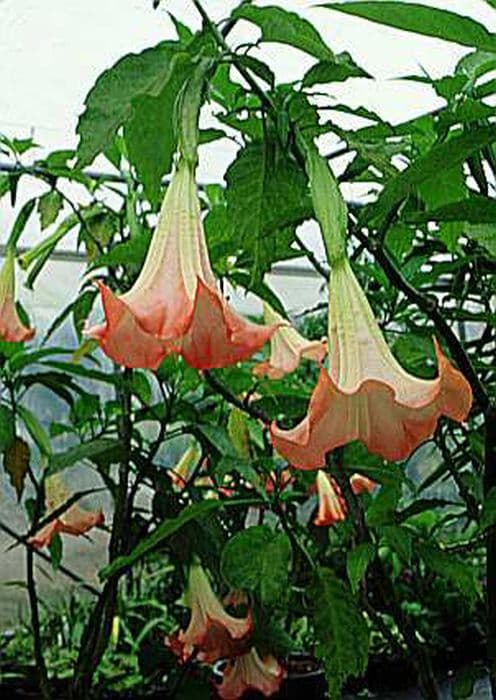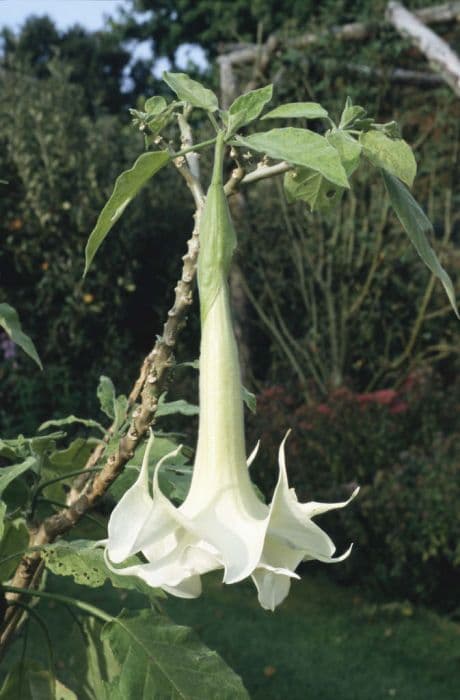Million Bells Calibrachoa Caloha Classic Honey White (Caloha Classic Series)
![calibrachoa [Caloha Classic Honey White]](/_next/image?url=https%3A%2F%2Fplants-admin.emdemapps.com%2Fimages%2Fplants%2F%2Fimages%2F604b5f56e0beb.png&w=3840&q=75)
ABOUT
The Calibrachoa Caloha Classic Honey White is a striking variety that is known for its vibrant and delicate nature. This particular variety boasts beautiful white flowers that are characterized by a unique honey-toned throat, which adds a lovely contrast and depth to the blooms. The flowers themselves are petite and resemble miniature petunias, with a soft and somewhat velvety texture to the petals. Each bloom possesses a funnel-like shape that opens up into a five-lobed corolla, exuding a charming simplicity that is typical of Calibrachoas. The foliage of the Caloha Classic Honey White is green and lush, providing a verdant backdrop for the pristine white blossoms. The leaves are small and narrow with a slightly pointed tip and are often densely packed along the stems, enhancing the full and bushy appearance of the plant. The foliage, though not the star, complements the flowers and overall aesthetic of the plant, making it a popular choice for gardeners and landscapers seeking to create eye-catching floral displays without overwhelming their space with large plants.
About this plant
 Names
NamesFamily
Solanaceae
Synonyms
Million Bells, Mini Petunia
Common names
Calibrachoa Caloha Classic Honey White.
 Toxicity
ToxicityTo humans
The plant commonly known as Million Bells is not typically known for its toxicity to humans. It is generally considered safe and there are no major concerns or reported cases of poisoning from ingesting parts of this plant. Therefore, it is unlikely to cause harm if accidentally ingested in small quantities. However, as with any plant, it is still advisable to keep it out of reach of children who might inadvertently eat parts of it, and to wash hands after handling any plant material to avoid potential irritation or allergic reactions.
To pets
Million Bells is also considered non-toxic to pets. It is not known to cause any serious symptoms of poisoning in animals such as dogs and cats if they happen to ingest parts of the plant. As with any non-food item ingestion, there is a small risk of gastrointestinal upset or discomfort, but significant toxicity is not expected. However, pet owners should still monitor their animals and ensure they are not eating plants as a habit, since even non-toxic plants can cause vomiting, diarrhea, or other mild gastrointestinal symptoms if consumed in larger amounts.
 Characteristics
CharacteristicsLife cycle
Annuals
Foliage type
Evergreen
Color of leaves
Green
Flower color
Honey White
Height
1 foot (30 cm)
Spread
2 feet (60 cm)
Plant type
Herb
Hardiness zones
9
Native area
South America
Benefits
 General Benefits
General Benefits- Easy to Grow: Calibrachoa is known for being easy to care for, making it suitable for gardeners of all levels.
- Long Blooming Period: It offers a long season of blooms, often from spring to fall, providing continuous color.
- Attracts Pollinators: The plant attracts beneficial pollinators like bees, butterflies, and hummingbirds to the garden.
- Drought Tolerant: Once established, Calibrachoa can tolerate short periods of drought, reducing the need for frequent watering.
- Versatile Use: Its trailing habit makes it perfect for hanging baskets, containers, and as a spiller in mixed plantings.
- Minimal Pest Issues: Calibrachoa generally experiences few problems with pests and diseases.
- Color Variety: Offering a wide range of colors, it allows for versatile design options in the landscape or garden.
- Compact Growth: With its compact growth habit, it's ideal for small spaces and doesn't overtake the garden.
- Low Maintenance: Requires minimal maintenance like occasional deadheading to promote more blooms.
 Medical Properties
Medical PropertiesThis plant is not used for medical purposes.
 Air-purifying Qualities
Air-purifying QualitiesThis plant is not specifically known for air purifying qualities.
 Other Uses
Other Uses- Photography Enhancements: The delicate flowers of Calibrachoa can be used to grace photography settings, adding a touch of natural beauty and softness to photo shoots.
- Educational Tool: These plants can be used as a subject in botany classes to teach students about the growth patterns and reproductive processes of flowering plants.
- Culinary Decoration: The blooms can be used to decorate cakes or desserts for a natural, edible garnish, as long as they have not been treated with pesticides.
- Artistic Inspiration: Artists may use Calibrachoa as a model for paintings, illustrations, or other forms of artistic representation.
- Homemade Dyes: The petals of Calibrachoa could potentially be boiled to create a light, honey-white dye for fabrics or crafts.
- Garden Competition: Enthusiasts might cultivate Calibrachoa for garden shows or local contests to showcase their gardening skills.
- Crafting: Dried Calibrachoa flowers can be incorporated into homemade potpourri or used to create natural jewelry like flower pendants.
- Literary Mention: Authors might include Calibrachoa in their writing to add vivid imagery or as a symbol of purity due to their white color.
- Themed Party Decor: Calibrachoa can be used for decoration in weddings or other events that have a white and honey color theme.
- Children’s Projects: The plants can be used in school projects or crafts, teaching children how to care for a living organism and observe its growth.
Interesting Facts
 Feng Shui
Feng ShuiThe plant Calibrachoa is not used in Feng Shui practice.
 Zodiac Sign Compitability
Zodiac Sign CompitabilityThe plant Calibrachoa is not used in astrology practice.
 Plant Symbolism
Plant Symbolism- Gratitude - The soft, cheerful blooms of the Calibrachoa, commonly referred to as "million bells," can symbolize a feeling of thankfulness, often given to express appreciation.
- Beauty - With its delicate honey white petals, the Calibrachoa is often associated with pure beauty, simplicity and grace.
- Longevity - As a plant that can bloom for an extended season, million bells may represent the wish for a long and prosperous life.
 Water
WaterMillion Bells should be watered thoroughly and allowed to dry out slightly between waterings. Generally, this means watering every few days, but the frequency will depend on the weather conditions and the size of the pot—more often in hot, dry conditions and less often in cooler, cloudy weather. A good approach is to provide about one inch of water per week, which in a standard pot might translate to roughly 16 to 32 ounces, adjusting as needed for the plant's environment and the soil's moisture level.
 Light
LightMillion Bells prefers full sun to partial shade for optimal growth. It thrives best when it has at least six hours of direct sunlight daily, so placing it in a spot where it can enjoy the morning sun with some protection from the intense afternoon rays is ideal. Avoid deeply shaded areas as this can lead to poor blooming and leggy growth.
 Temperature
TemperatureMillion Bells grows best in temperatures between 55°F and 65°F at night and 65°F to 85°F during the day. It can survive down to around 20°F but will not tolerate frost and should be protected from cold temperatures. Ideal growing conditions are within the moderate temperature range where the plant can avoid extreme heat or cold.
 Pruning
PruningMillion Bells benefits from light pruning to encourage bushier growth and more blooms. Deadheading is not necessary for this plant as it is self-cleaning, but pinching back the stems every few weeks can help maintain a fuller shape and promote continuous flowering. The best time for pruning is early spring or when the plant starts to look leggy.
 Cleaning
CleaningAs needed
 Soil
SoilMillion Bells prefer a well-draining soil mix with peat moss or coconut coir, perlite, and compost. Aim for a slightly acidic to neutral pH of 5.5 to 6.5 for optimal growth.
 Repotting
RepottingMillion Bells should be repotted every year or when rootbound, using fresh soil to replenish nutrients and space for roots to grow.
 Humidity & Misting
Humidity & MistingMillion Bells thrive in moderate humidity levels, ideally between 40% to 70%, avoiding extremes to maintain plant health.
 Suitable locations
Suitable locationsIndoor
Place in bright, indirect light and moderate humidity.
Outdoor
Full to partial sun, shelter from harsh elements.
Hardiness zone
9-11 USDA
 Life cycle
Life cycleThe life cycle of the Calibrachoa 'Caloha Classic Honey White' begins with seed germination. Optimal temperatures and moisture conditions cause the seeds to sprout, typically occurring in spring if outdoors or under controlled conditions in a nursery. Following germination, the seedlings develop into young plants, displaying their characteristic small green leaves. As it enters the vegetative stage, the plant grows rapidly and begins to form a dense mat of foliage. Flowering occurs soon after, usually in the late spring through summer, showcasing the Calibrachoa's white blossoms with a yellow throat. After the flowering season, seeds are produced and dispersed, allowing the cycle to start anew, while the parent plant may continue to live and rebloom for several seasons if properly cared for.
 Propogation
PropogationPropogation time
Spring-Early Summer
Calibrachoa, also commonly known as million bells, is easily propagated by taking stem cuttings, which is the most popular method for this plant. The best time to take cuttings is in the spring or early summer when the plant is actively growing. Here's a brief overview of how to propagate Calibrachoa Caloha Classic Honey White using stem cuttings: Cut a 3 to 4-inch piece from a healthy stem, making sure to include several leaf nodes. Remove the leaves from the lower half of the cutting to prevent rotting and dip the cut end into rooting hormone powder to encourage root growth. Plant the cutting in a well-draining soil mix, and keep it moist but not overly wet by covering it with plastic to maintain humidity. Place the cutting in bright, indirect light and wait for roots to develop, which typically takes several weeks. Once rooted, the new Calibrachoa can be transplanted into a larger pot or directly into the garden.


![Calibrachoa [Aloha Classic Blue Sky]](/_next/image?url=https%3A%2F%2Fplants-admin.emdemapps.com%2Fimages%2Fplants%2F%2Fimages%2F604b636c3778b.png&w=640&q=75)
![Calibrachoa [Aloha Classic Gold]](/_next/image?url=https%3A%2F%2Fplants-admin.emdemapps.com%2Fimages%2Fplants%2F%2Fimages%2F604b6284c573e.png&w=640&q=75)
![Calibrachoa [Aloha Classic Tiki Soft Pink]](/_next/image?url=https%3A%2F%2Fplants-admin.emdemapps.com%2Fimages%2Fplants%2F%2Fimages%2F604b548e0a5ef.png&w=640&q=75)
![Calibrachoa [Cabaret Deep Yellow]](/_next/image?url=https%3A%2F%2Fplants-admin.emdemapps.com%2Fimages%2Fplants%2F%2Fimages%2F604b5f20ca3ef.png&w=640&q=75)
![Calibrachoa [Calibasket Radiant Orange]](/_next/image?url=https%3A%2F%2Fplants-admin.emdemapps.com%2Fimages%2Fplants%2F%2Fimages%2F604b536d43cb2.png&w=640&q=75)
![Calibrachoa [Caloha Classic Blue Velvet]](/_next/image?url=https%3A%2F%2Fplants-admin.emdemapps.com%2Fimages%2Fplants%2F%2Fimages%2F604b604884a75.png&w=640&q=75)
![Calibrachoa [Caloha Classic Yellow Chocolate Ring]](/_next/image?url=https%3A%2F%2Fplants-admin.emdemapps.com%2Fimages%2Fplants%2F%2Fimages%2F604b538aede95.png&w=640&q=75)
![Calibrachoa [Caloha Grand Purple]](/_next/image?url=https%3A%2F%2Fplants-admin.emdemapps.com%2Fimages%2Fplants%2F%2Fimages%2F604b6192993d2.png&w=640&q=75)